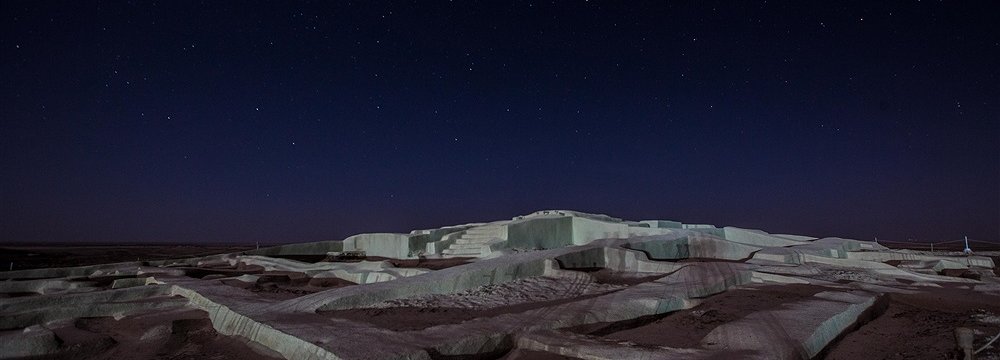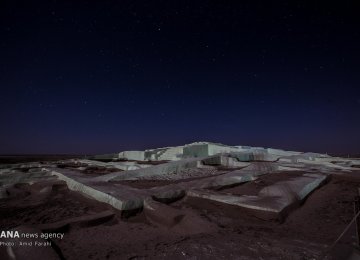The city, called Shahr-e-Sookhteh (Burnt City), sits on the banks of the Helmand River between the cities of Zabol and Zahedan, in Iran’s southeast province of Sistan-Baluchestan.
The city is a Bronze Age archeological treasure trove, which was once one of the world’s largest communities at the dawn of urban settlement.
Built around 3200 BC, the city covered an area of about 151 hectares. Four civilizations appear to have resided in the city, once a trade centre for merchants from Mesopotamia, Indus Valley and Central Asia; it was perhaps the first complex society in eastern Iran.
It was burnt down three times and was eventually abandoned over a millennium later in 2100 BC. Despite the excavations and studies carried out at the site, the reasons for the unexpected rise and fall of the Burnt City still seem to remain a mystery. The real name of the city is also unknown. It took its eventual name around 200 years ago because it was never rebuilt after the last fire.
The excavations at the Burnt City also suggest that the inhabitants were a race of civilized people who were both farmers and craftsmen. No weapon has ever been discovered at the site, suggesting the peaceful nature of the residents.
The site was discovered in 1967 and has been continually excavated since the 1970s by Iranian and Italian archaeological teams with new discoveries being reported all the time.
It is fascinating for archeologists and historians alike because the layer of salt and nitrate that exists in the soil has caused many of the artifacts to be incredibly well preserved.
Among the many items preserved were food items such as coriander, cumin, and wild pistachio, which remain staples of Persian cuisine.
Oldest Known Brain Surgery
Far more astounding however, is the discovery of a human skull with signs that suggest a brain surgery was conducted in this prehistoric city. 4,800 years ago, the cranial surgery was undertaken on the skull of a young woman of about 12 or 13 years who survived for between 9 and 12 months after the surgery.
The striking find is reminiscent of “The Story of Sinuhe”, written in hieroglyph during the Egyptian Middle Kingdom around 2000 BC, in which Sinuhe, an Egyptian nobleman and a physician in the court of Amenemhet I, gives an account of open brain surgeries.
The unearthed skull in Iran’s Burnt City has discredited the belief based on Sinuhe’s account that brain surgery originated in Egypt.
First Ever Artificial Eye
In December 2006, archaeologists discovered the world’s earliest artificial eyeball. It has a hemispherical form and a diameter of just over 2.5 cm. It consists of very light material, probably bitumen paste. The surface is covered with a thin layer of gold, engraved with a central circle (representing the iris) and gold lines patterned like sun rays. The female remains found with the artificial eye was 1.82 m tall, much taller than ordinary women of her time. On both sides of the eye are drilled tiny holes, through which a golden thread could hold the eyeball in place. Since microscopic research has shown that the eye socket showed clear imprints of the golden thread, the eyeball must have been worn during her lifetime. The woman’s skeleton has been dated to between 2900 and 2800 BC.
Oldest Known Backgammon Game
The oldest known backgammon and dice were also uncovered on the ancient site, which is older than the game uncovered in the ancient city of Ur (in present day Iraq). The unearthed board game is made of 60 pieces of turquoise and agate, and has a rectangular ebony board. On its base a carved picture of a snake that winds around designating where the game pieces should be placed on the board, strongly resembles the game of snakes and ladders.
First Animation
An earthen goblet depicts what archeologists consider to be the first animation. The first pictorial animation can be seen illustrated on a ceramic 4-legged pot which depicts a goat in five different positions, which when seen in relay, the image is seem to jump up, eat from the plant and descend back down
Mothers had socioeconomic prominence
Some paleoanthropologists believe that mothers in the Burnt City had social and financial prominence. 5000 year-old insignias, made of river pebbles and believed to belong only to distinguished inhabitants of the city, were found in the graves of some female citizens. Some believe the female owners of the insignias used them to place their seal on valuable documents. Others believe the owners may have used the seal to indicate their lofty status in society.
Necropolis
More than 600 skeletal remains have also been unearthed so far from the Burnt City’s necropolis. The remains had been buried in more than 108 graves with some of the remains grouped together into graves containing three to eight bodies. At least two of the multiple graves were family plots apparently intended for family members who had died within a short period of time of each other.
The deceased residents of the Burnt City were buried in different positions - some were buried prostrate, some in a supine position and some lying on one-side. The most frequent position in burial was to lay the corpse on its side or to position the body into a kind of squat. Scientists believe that the variety in burial methods implies that different cultures coexisted within one society at the Burnt City.
Teeth as Tool
Paleopathological studies on 40 teeth unearthed in the Burnt City’s cemetery show that the inhabitants of the city used their teeth as a tool for weaving to make baskets and other handmade products.
“More than 40 teeth lesions have been identified, the most prominent of which belongs to a young woman who used her teeth as a tool for weaving baskets and similar products,” said Farzad Forouzanfar, director of the Anthropology Department of Iran’s Archeology Research Center and head of the anthropology team at the Burnt City in an interview with CHN.
The use of teeth as a tool in the Burnt City is seen in both males and females of different age groups. Evidence shows that weaving was more than a hobby in the prehistoric city. It was one of the most common professions in the city which required a special skill. Residents made a variety of woven products such as carpets, baskets, and other household items.





